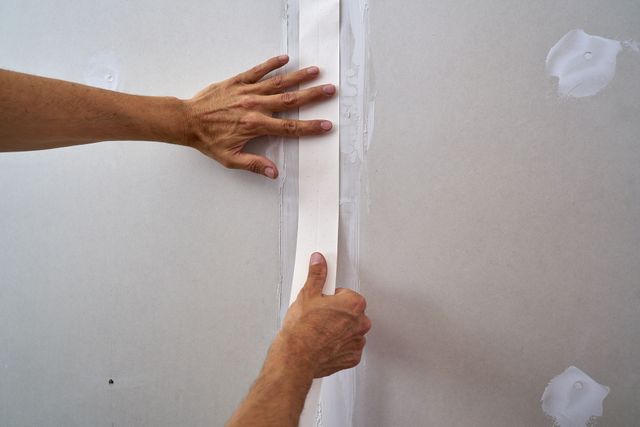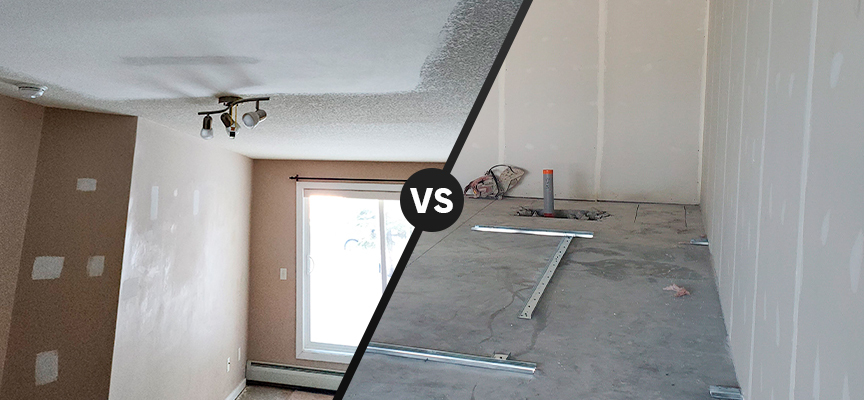A Comprehensive Overview to Learning Drywall Repair Service and Setup
This overview provides a comprehensive expedition of drywall fixing and installation, accommodating both newbies and seasoned specialists. It describes important tools, strategies for patching and hanging sheets, and the important completing procedures. Drywall Installation Ogden Utah. By comprehending usual risks, people can attain refined outcomes. Grasping these abilities not only improves one's home however likewise constructs self-confidence in DIY undertakings. What foundational tips will assure an effective project from start to complete?
Vital Devices for Drywall Fixing and Installation
When starting on drywall repair work and setup, a couple of important tools can greatly enhance the performance and quality of the job. A drywall knife, typically offered in different sizes, is important for applying joint compound and smoothing seams. A taping knife is also needed for feathering edges and ensuring a seamless finish. Additionally, a drywall saw or utility knife enables accurate cutting of drywall sheets to fit any area.

Step-by-Step Overview to Patching Holes
Covering openings in drywall is a straightforward procedure that can recover the wall surface's look and stability. To start, the area around the opening need to be cleansed and any kind of loosened particles eliminated. For small holes, a simple spackle or joint substance can be applied with a putty knife. Bigger holes might need a patch; a piece of drywall can be reduced to fit the hole, protected with adhesive or screws, and after that taped around the edges. When the spot remains in area, joint compound is applied over the spot and feathery bent on mix with the bordering wall. After the substance dries, sanding is essential to attain a smooth finish. Finally, the fixed location can be primed and repainted to match the remainder of the wall. This technique assures a smooth repair work, enhancing the general appearance of the drywall and maintaining its structural honesty.
Strategies for Hanging Drywall Sheets
After successfully fixing openings in drywall, the next step involves hanging new drywall sheets to develop a seamless surface. To attain this, one have to begin by determining the wall room properly and reducing the drywall sheets to fit. It is crucial to hang the sheets horizontally for much better structural stability, starting from the top and working downwards.
Using a drywall lift can simplify the process, particularly for ceiling installations. When placed, safeguarding the sheets with drywall screws at intervals of about 12 inches along the edges and 16 inches in the field is necessary. This assures a strong hold and decreases the risk of sagging. For edges, the sheets must be reduced to fit comfortably, permitting cleaner seams. It is suggested to stagger the joints between sheets to reinforce the total framework, creating a much more long lasting surface all set for the next stage in the drywall installment procedure.
Finishing Touches: Insulation and Mudding
Completing the drywall installment includes the vital actions of mudding and taping, which assure a polished and smooth coating. Insulation requires the application of joint tape over the joints in between drywall sheets. Drywall Repair Ogden UT. This tape can be either paper or fiberglass mesh, with each type offering distinct benefits. After taping, the following step is mudding, where joint compound, or "mud," is used to cover the tape and fill any type of imperfections
Utilizing a drywall blade, the substance should be spread out evenly, get more info ensuring a feathery edge to reduce noticeable modifications. Multiple layers are frequently essential, with sanding in between each layer to accomplish a smooth surface. Cautious attention throughout this process is crucial, as it greatly impacts the last appearance of the wall. With the best strategy and patience, completion outcome will be a remarkable structure all set for paint or completing touches.
Common Blunders to Prevent in Drywall Projects

One more typical mistake is not permitting enough drying time in between layers, which can trap wetness and compromise the finish. Neglecting to feather the sides effectively can create visible lines and blemishes. Ultimately, missing sanding or using inappropriate strategies might leave rough places. By being conscious of these mistakes, individuals can greatly improve the quality of their drywall jobs and accomplish a professional-looking surface.
Often Asked Inquiries
Can I Repair Drywall Without Professional Help?
Yes, one can repair drywall without specialist help. With the right tools, products, and support, people can successfully manage small repairs. Substantial damage might require professional knowledge for ideal outcomes and resilience.
Just How Lengthy Does Drywall Substance Require To Dry?
Drywall compound generally takes in between 24 to two days to completely dry totally, depending on elements such as moisture and temperature. Thinner layers might dry faster, while thicker applications call for more time for excellent results.
What's the Finest Sort Of Paint for Drywall?
The very best sort of paint for drywall is normally a water-based latex paint. It provides superb coverage, durability, and ease of application, making it excellent for indoor walls while allowing for very easy cleaning with soap and water.

How Do I Protect Against Mold on Drywall?
To avoid mold and mildew on drywall, assurance appropriate air flow, control humidity degrees, make use of mold-resistant products, and immediately address any kind of leaks. Normal evaluations and instant remediation of water damage are additionally crucial for lasting avoidance.
Is Drywall Recyclable After Removal?
Drywall is recyclable after removal, gave it is free from contaminants like mold, paint, or other unsafe materials. Recycling centers can process it into new products, advertising sustainability and minimizing land fill waste in construction.
When starting on drywall fixing and installment, a couple of essential devices can considerably boost the effectiveness and quality of the work. After successfully repairing openings in drywall, the next action entails hanging brand-new drywall sheets to create a smooth surface. Finishing the drywall installment includes the vital steps of taping and mudding, which guarantee a refined and smooth surface. Attaining a sleek finish in drywall tasks can be tough, and a number of usual blunders can weaken the top quality of the job. Yes, one can repair drywall without professional help.